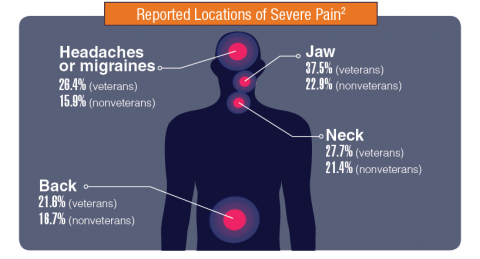Chronic pain is a major public health problem that affects more than 100 million people in the U.S. and is even more prevalent among active-duty service members and veterans. According to the National Institutes of Health, the prevalence of persistent pain is expected to rise in the near future, as the incidence of associated diseases (including diabetes mellitus, obesity, cardiovascular disorders, arthritis, and cancer) increases in the aging U.S. population.
Perhaps no other health care problem is more persistent and more vexing than pain for the VA and DoD health care systems. Close to half of the soldiers who served in Afghanistan and nearly two-thirds of veterans reported chronic pain. Headaches and severe pain in the jaw, neck, and back are the most commonly reported locations. Veterans were far more likely than nonveterans were to experience severe pain in each of those locations.
Both the VA and DoD have recognized the dangers posed by high-levels of opioid prescriptions. While only 23% of veterans reported using opioid prescriptions for managing their chronic pain, the VA and DoD have actively sought to reduce the morphine equivalent daily doses for patients on opioids or to eliminate the prescriptions altogether. Through Centers of Excellence, such as the Defense & Veterans Center for Integrative Pain Management, the DoD and VA also have explored alternatives to opioids for pain management. In addition, the VA has used shared medical appointments and conjoint sessions with pharmacists and health psychologists to find alternative treatments and to educate patients about the dangers of opioid therapies for chronic pain.





